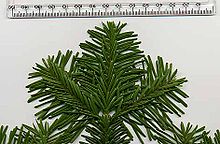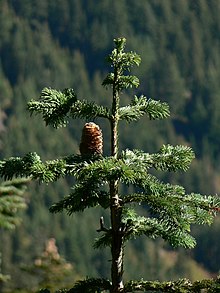Abies amabilis
| Pacific silver fir | |
|---|---|

| |
| Pacific silver fir foliage from above | |
| Scientific classification | |
| Kingdom: | Plantae |
| Clade: | Tracheophytes |
| Clade: | Gymnospermae |
| Division: | Pinophyta |
| Class: | Pinopsida |
| Order: | Pinales |
| Family: | Pinaceae |
| Genus: | Abies |
| Species: | A. amabilis
|
| Binomial name | |
| Abies amabilis J.Forbes | |

| |
| Range | |

Abies amabilis, commonly known as the Pacific silver fir, is a fir native to the Pacific Northwest of North America, occurring in the Pacific Coast Ranges and the Cascade Range. It is also commonly referred to in English as the white fir, red fir, lovely fir, amabilis fir, Cascades fir, or silver fir.[2][3] The species name is Latin for 'lovely'.[2]
Description
The tree is a large
The tree can live to over 400 years old.[4]
Pacific silver fir is very closely related to
Distribution and ecology
The species is native to the Pacific Northwest of North America, occurring in the Pacific Coast Ranges and the Cascade Range from the extreme southeast of Alaska, through western British Columbia, Washington and Oregon, to the extreme northwest of California. It grows from sea level to 1,000 m (3,300 ft) in the north of the range, and to 610–2,000 m (2,000–6,560 ft) in the south of the range. Populations on the east slope of the Cascades are confined to elevations above 1,000 m (3,300 ft) in Washington and 1,160 m (3,810 ft) in Oregon.[6]
It is always found in
Uses
Indigenous Nations, including but not limited to the Nuxalk, Haisla, and Kitasoo Nations, interacted with Abies amabilis or Silver Fir for medicinal purposes.[4] Ethnobotanist Daniel Moerman notes, for example, that Nuxalk Peoples mixed mountain goat tallow with liquid pitch to treat sore throat. An infusion of bark, by contrast, may have been used to address stomach issues.[8]
Indigenous Nations not only engaged with Abies amabilis or Silver Fir medicinally, but entered into nourishing relationships with this Plant Relation. Hardened pitch was sometimes chewed for pleasure by the Ditidaht Peoples.[8]
Seeds were not brought to England for cultivation until the 19th Century. David Douglas is responsible for transporting seed abroad in 1825. [4]
The wood is soft and not very strong; settler-colonists have thus tended to use this species for paper making, packing crates and other cheap construction work.[4] The lumber is often paired with that of western hemlock.[4]
The foliage has an attractive scent and is sometimes used for Christmas decoration, including Christmas trees.[citation needed]. Long before the arrival of settler-colonists, Abies amabilis or Silver Fir was admired for its scent. Ditidaht Peoples brought boughs into their home as an air freshener, whereas Nlakaʼpamux Peoples boiled boughs to create unique plant-based hair perfumes.[8]
Today, Abies amabilis or Silver Fir is sometimes planted as an
References
- . Retrieved 19 November 2021.
- ^ a b c "Abies amabilis". Gymnosperm Database. 2011. Retrieved December 3, 2021.
The epithet amabilis means 'lovely.
- ^ "Interactive Distribution Map of Abies amabilis". Archived from the original on 2015-10-23. Retrieved 2010-07-12.
- ^ OCLC 1141235469.
- ^ "Abies amabilis in Flora of North America @ efloras.org". www.efloras.org.
- ^ Crawford, Peggy D.; Oliver, Chadwick Dearing (1990). "Abies amabilis". In Burns, Russell M.; Honkala, Barbara H. (eds.). Conifers. Silvics of North America. Vol. 1. Washington, D.C.: United States Forest Service (USFS), United States Department of Agriculture (USDA). Retrieved 23 April 2023 – via Southern Research Station.
- ^ "California Buckeye (Aesculus californica) – photo/images/information". GlobalTwitcher.com. November 22, 2012. Archived from the original on 2012-11-22.
- ^ ISBN 9780881924534.





